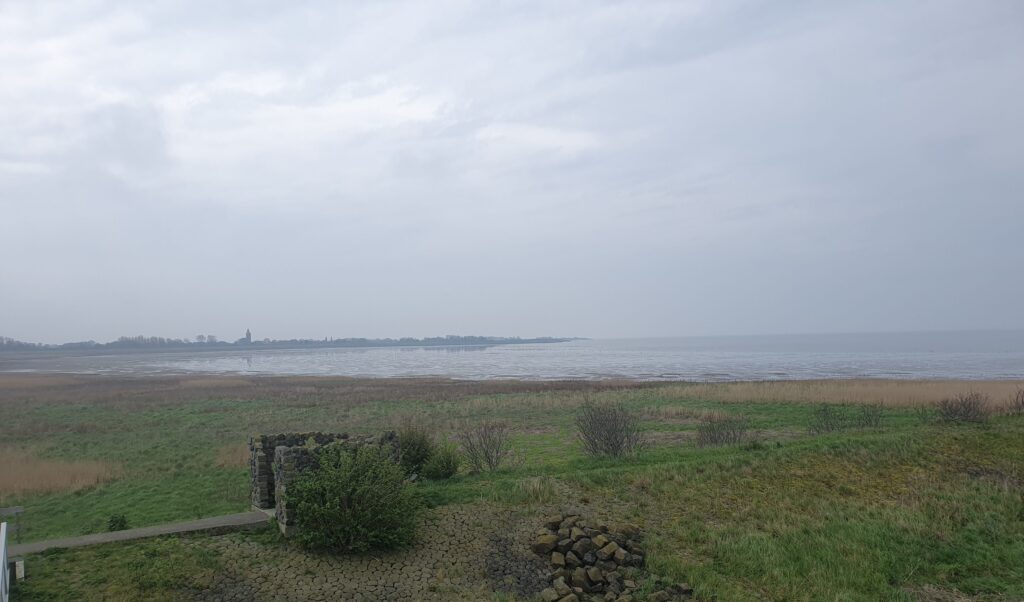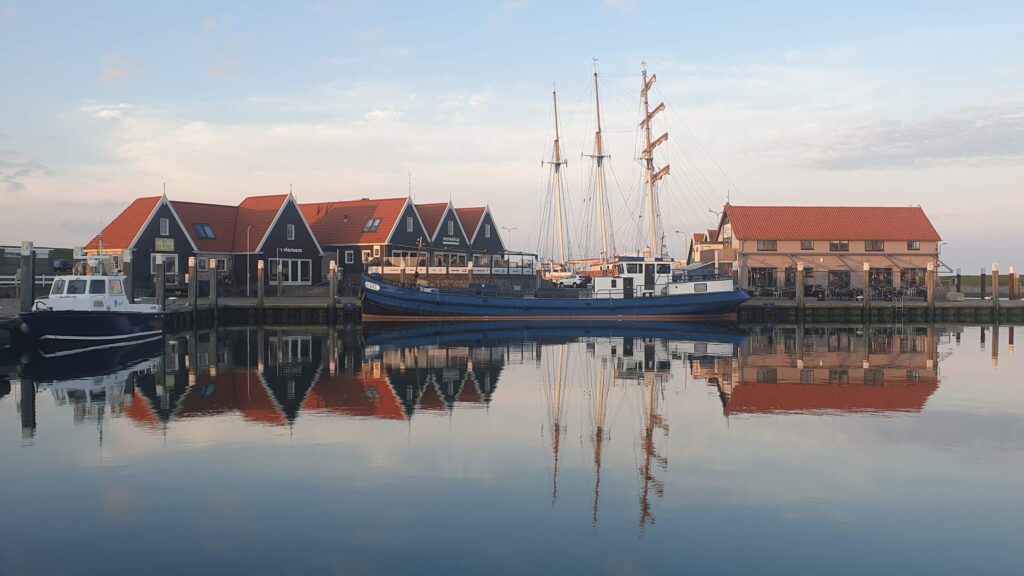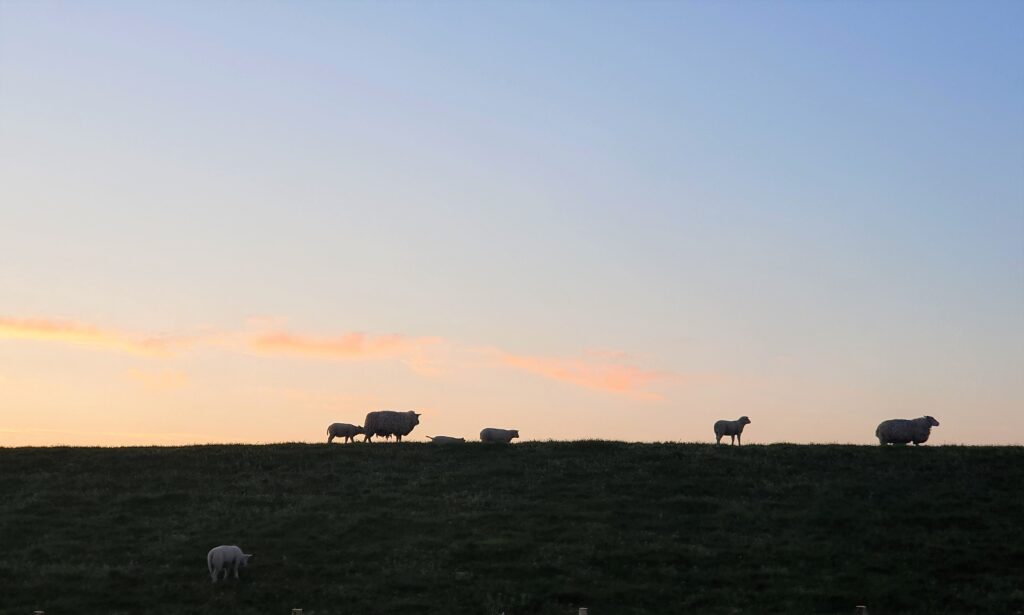Waddeneiland

Texel
Texel
Sprich: „Tessel“!
Gestern Nachmittag haben wir versucht, aus Gezeitentabellen und Strömungsatlas den idealen Zeitpunkt für den Aufbruch von Den Oever herauszufinden. In der Komplexität der Watten-Ströme ist das gar nicht so einfach. Letztlich sind wir dann aufgebrochen, als der Regen kam.
Say: „Tessel“!
Yesterday afternoon we tried to find out from tide tables and current atlas the ideal time to set off from Den Oever. In the complexity of the Wadden currents, this is not so easy. In the end, we set off when the rain came.
Weil wir zwischen den Informationen aus dem Törnführer, den Gezeitentafeln und dem Strömungsatlas einen vermeintlichen Widerspruch zu erkennen glauben, fragen wir noch einen Stegnachbarn nach seiner Meinung. Der meint, dass er sich in dem Fall immer am Pegel von Den Helder orientiert, was einen Aufbruch um ca. 15:30 bedeuten würde. Dann könnten wir bis kurz vor Den Helder mit dem Ebbstrom fahren und hätten für das letzte Stück bis Oudeschild auf Texel den steigenden Flutstrom mit uns.
Um etwa 15:15 setzt ziemlich starker Regen ein, aber die Gezeiten haben Vorrang. Fast zwei Stunden motoren wir gegen den Westwind bei strömendem Regen und maximal 10 ° C. Matthias steht unermüdlich und unerschütterlich am Steuer und trotz der ungemütlichen Verhältnisse bleibt die Stimmung fröhlich und optimistisch.
Because we think we see a contradiction between the respective information in the sailing guide, the tide tables and the current atlas, we ask a neighbour on the jetty for his opinion. He says that in this case he always orientates himself on the water level of Den Helder, which would mean setting off at about 15:30. Then we could sail with the ebb current until just before Den Helder and have the rising tide with us for the last stretch to Oudeschild on Texel.
At about 15:15 it starts to rain pretty hard, but the tide takes precedence. We motor against the westerly wind for almost two hours in pouring rain and a maximum of 10 ° C. Matthias is tireless and steadfast at the helm and despite the uncomfortable conditions, the mood remains cheerful and optimistic.
Wir beobachten genau die Fahrwasser-Tonnen, die an uns vorüberziehen und stellen fest, dass der Ebbstrom stärker ist, als erwartet. Dreimal müssen wir die richtige Abzweigung erwischen, dann können wir einen Teil der Strecke abkürzen, weil wir mit unseren 1,65 m Tiefgang nicht die ganze Kurve ausfahren müssen, um in den Texel-Strom nach Norden abzubiegen.
Hier stellen wir fest, dass wir noch immer Strom gegen uns haben, obwohl in Den Helder Niedrigwasser schon seit einer halben Stunde vorüber ist. Wir können uns das nicht erklären, stellen aber fest, dass der Strömungsatlas die „bessere“ Abfahrtszeit geliefert hätte. Inzwischen hat auch der Regen aufgehört und wir motoren gegen den ein Knoten starken Strom an, bis wir die Marina von Oudeschild erreichen.
We closely watch the fairway buoys passing us and notice that the ebb current is stronger than expected. Three times we have to catch the right turn, then we can shorten part of the distance, because with our 1.65 m draught we don’t have to go all the way out to turn north into the Texel Current.
Here we notice that we still have current against us, although low tide has been over in Den Helder for half an hour. We can’t explain this, but realise that the current atlas would have provided the „better“ departure time. In the meantime, the rain has also stopped and we motor against the one knot current until we reach the marina of Oudeschild.
Im Passantenhaven von Oudeschild ist um diese Zeit noch jede Menge Platz und wir können uns in Ruhe einen Liegeplatz aussuchen. Langsam reißt die Wolkendecke auch auf und der Hafen ist bald in ein wunderschönes Abendlicht getaucht. Wir suchen uns ein gemütliches Restaurant und genießen ein feines Abendessen mit anschließendem Hafenrundgang. Weil die nächsten Tage recht viel Wind wehen wird, wollen wir mindestens drei Tage hier bleiben.
Beim Abendessen diskutieren wir noch einmal die Abweichung zwischen Strömungsatlas und Gezeitenhöhe. Wir vergleichen schließlich die Situation mit einem Fluss, der im Oberlauf zwar von den Gezeiten aufgestaut wird, aber nicht zwingend die Flussrichtung ändern muss. Die Priele, in denen das Wasser im Wattenmeer abfließt, können daher noch weiter fließen, auch wenn an einem bestimmten Punkt der niedrigste Wasserstand erreicht ist. Es gibt nur wenige Punkte im Watt, an denen das Wasser tatsächlich zum Stillstand kommt. Die „globale“ Flutwelle, die über den Umweg um Schottland herum auf die niederländische Küste trifft, kommt zu unterschiedlichen Zeiten an den Seegatten, den Öffnungen zwischen den Inseln, an und erzeugen im Watt ein sehr komplexes und hochdynamisches System an Strömungen und Pegelständen. Die einfache Vorstellung, dass sich jeweils bei Niedrig- und Hochwasser einfach die Strömungsrichtung ändert, ist offenbar falsch.
Hätten wir das vorher gewusst, hätten wir erst nach dem Regenschauer wegfahren müssen und wären bei Sonnenschein angekommen.
At this time of the day, there is still plenty of room in the harbour of Oudeschild and we can choose a mooring in peace and quiet. Slowly the cloud cover breaks and the harbour is soon bathed in a beautiful evening light. We look for a cosy restaurant and enjoy a fine dinner followed by a tour of the harbour. Because there will be a lot of wind over the next few days, we want to stay here for at least three days.
During dinner we discuss the discrepancy between the current atlas and the height of the tide once again. We finally compare the situation with a river that is dammed up by the tides in its upper course, but does not necessarily have to change its direction. The tideways where the water drains off in the Wadden Sea can therefore continue to flow even when the lowest water level is reached at a certain point. There are only a few points in the tidal flats where the water actually comes to a standstill. The „global“ tidal wave, which reaches the Dutch coast via the diversions around Scotland, arrives at the sea gates, the openings between the islands, at different times, creating a very complex and highly dynamic system of currents and water levels in the mudflats. The simple idea that the direction of the current simply changes at low and high tide is obviously wrong.
If we had known this beforehand, we would have had to leave after the rain shower and arrived in sunshine.








Nice to read the Update. Beautiful pictures too!
Enjoy Texel [‚Tessel‘] and take care.